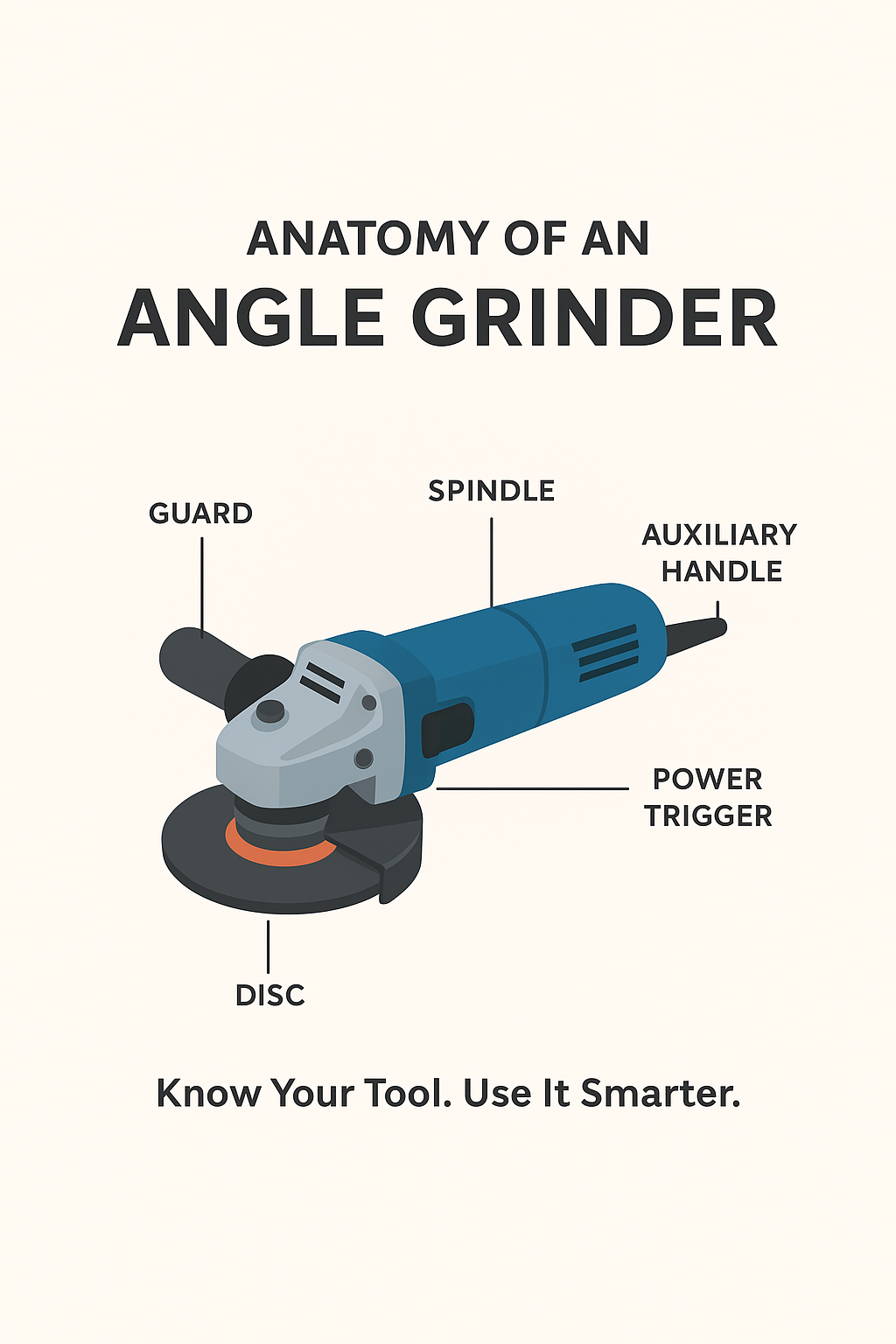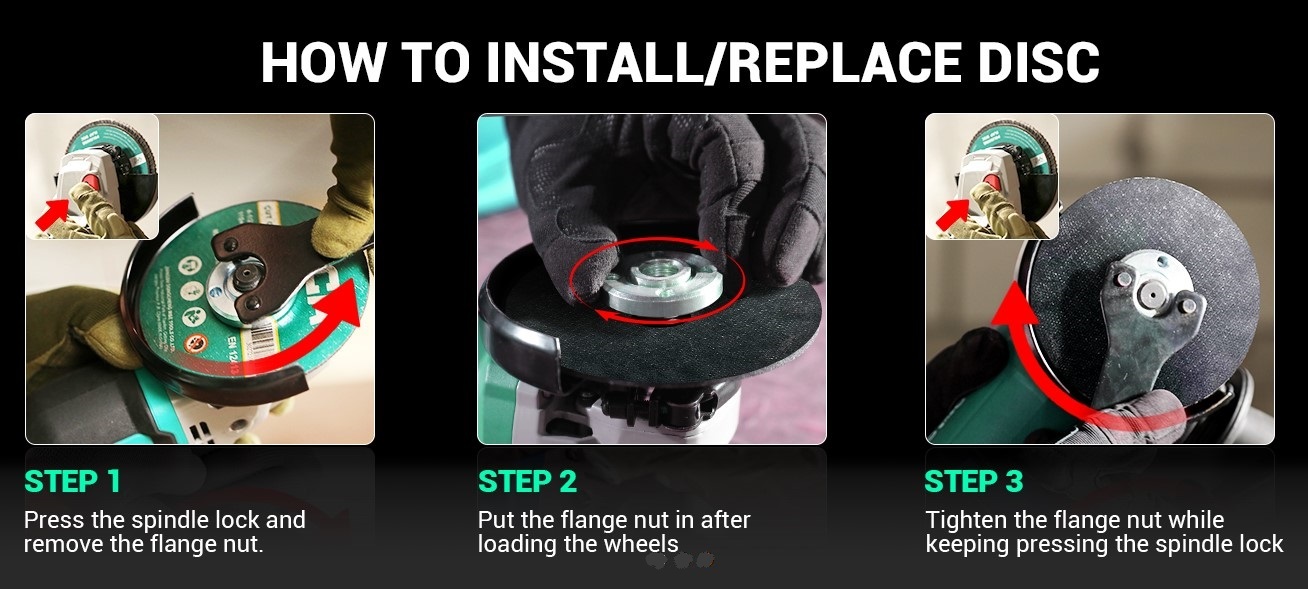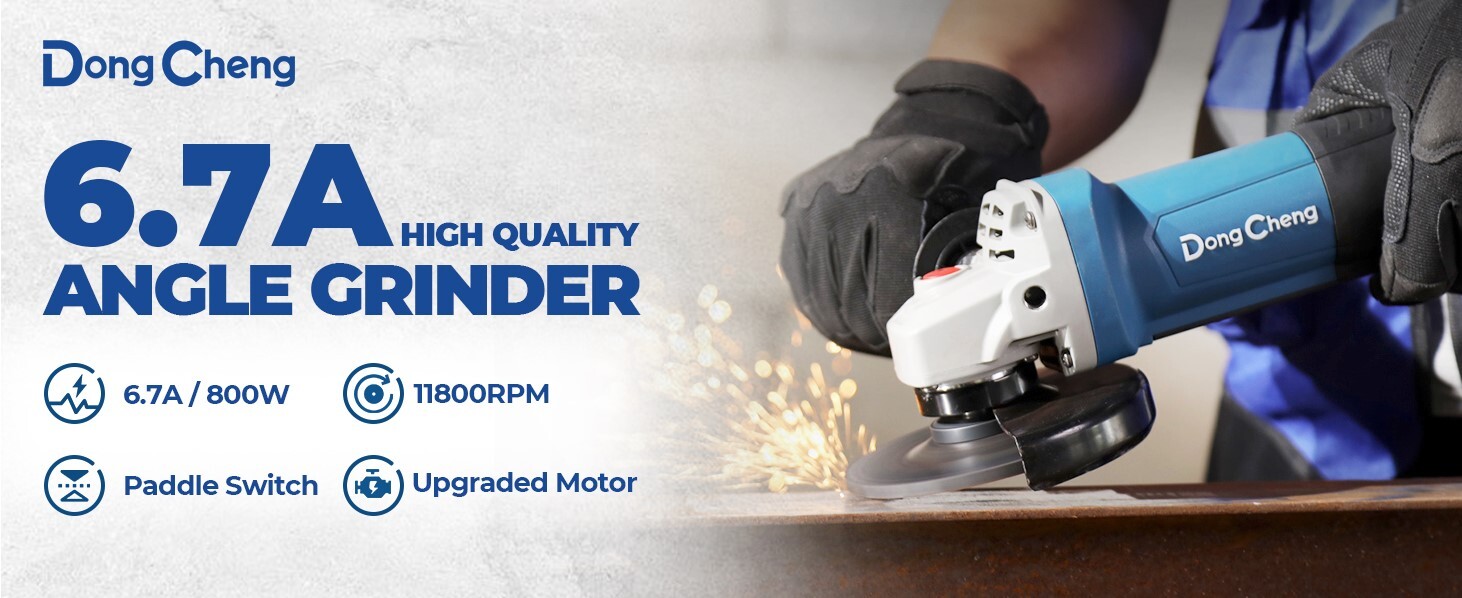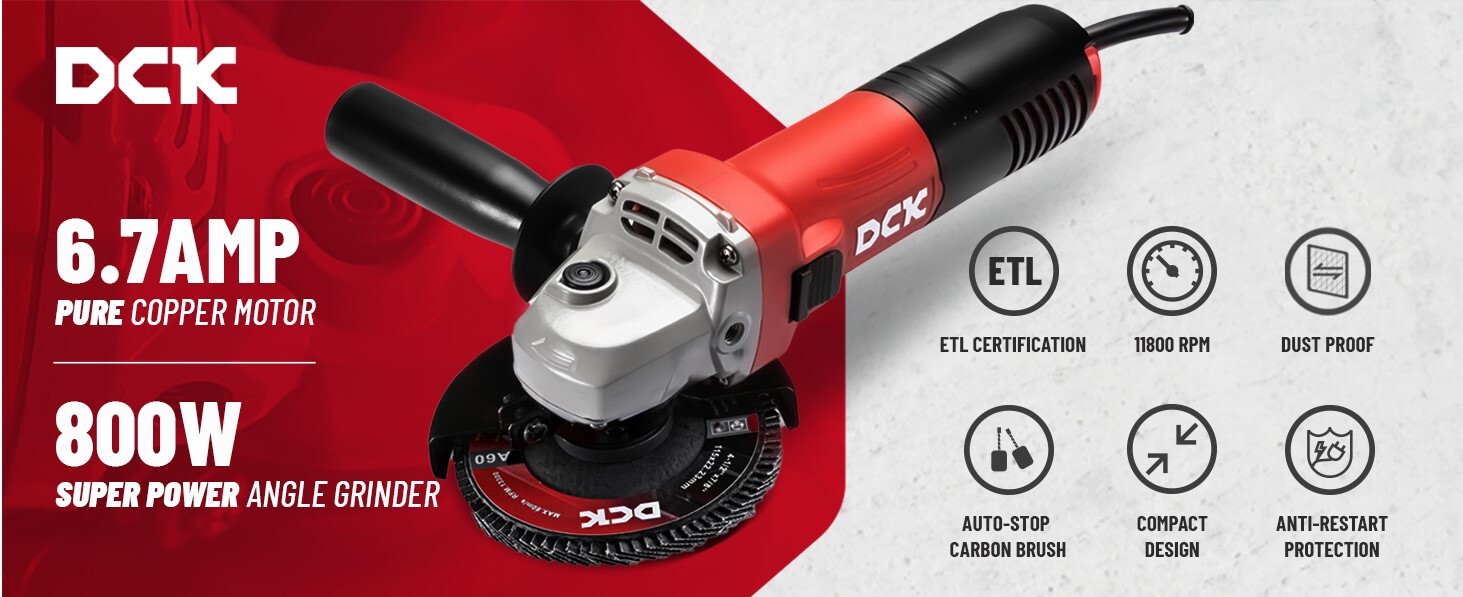What Is an Angle Grinder Used For? 10 Everyday Tasks Made Easier
If you’ve ever walked through a workshop or past a construction site, you’ve almost certainly heard its high-RPM whine. But for many homeowners and DIYers, the angle grinder remains one of the most intimidating and misunderstood, tools on the shelf. Often seen as a single-purpose tool for cutting metal, you might be shocked to learn it's actually the Swiss Army knife of your power tool collection.
So, what is an angle grinder used for? With a simple disc change, this one tool can cut, grind, sand, polish, and sharpen a huge variety of materials.
Modern, high-performance grinders are no longer just for heavy industry. Powerful and affordable models like the DCK 4-1/2-Inch Grinder, the safety-focused DongCheng Paddle Switch Angle Grinder, and the go-anywhere DCA 20V Brushless Cordless Grinder have brought professional-grade versatility to the home garage.
Let's explore the 10 everyday tasks this single tool makes faster, easier, and more efficient.
Amazon Affiliate Disclosure:
Tend Supplies is a participant in the Amazon Services LLC Associates Program, an affiliate advertising program designed to provide a means for sites to earn fees by linking to Amazon.com and affiliated sites. As an Amazon Associate, we earn from qualifying purchases. We only recommend products we genuinely believe in, which helps us continue to create valuable content for our readers.
Key Takeaways:
- The Disc Defines the Job: An angle grinder's true function, whether cutting metal, grinding welds, removing rust, sanding wood, or cutting tile is determined entirely by the disc you attach, making it one of the most versatile tools in any workshop.
- Safety is Non-Negotiable: Due to its high RPM (often 11,800+), you must always use the safety guard (like the 2 included with the DCK grinder) and wear a full-face shield (not just safety glasses) to protect against debris and potential disc failure.
- 4-1/2" is the DIY Standard: The 4-1/2 inch (115mm) grinder size is the most popular and versatile choice for home workshops, offering the best balance of power, control, and the widest availability of discs.
- Choose Your Power (and Features): Your project determines your tool. For unlimited runtime and maximum power, a corded model (like the 6.7-Amp DCK or DongCheng) is ideal. For convenience and working in remote areas, a cordless model (like the DCA 20V Brushless) is superior. Prioritize safety features like the DongCheng's paddle switch for added protection.
- Versatility Beyond Metal: The angle grinder is a master of surface preparation. It excels at removing rust (with a flap disc or wire wheel), cutting tile and concrete (with a diamond blade), and sharpening garden tools, saving you time and money on multiple other specialized tools.
What Is an Angle Grinder?
An angle grinder (also called a disc grinder or side grinder) is a handheld power tool used for cutting, grinding, sanding, and polishing. Powered by electricity or batteries, it features a rotating abrasive disc that spins at extremely high speeds often over 11,000 RPM to remove material or create smooth finishes.
Why It’s a Workshop Essential
- Versatile: Works on metal, wood, stone, tile, and plastic.
- Compact: Easy to handle in tight spaces.
- Durable: Designed for repeated heavy-duty tasks.

Includes cutting & grinding wheels, flap discs, auxiliary handle, and dual safety guards.
The Key to Versatility: The Disc
The tool's true function is defined by the disc you attach to it. Changing the disc changes the job. A thin disc cuts metal, a thick one grinds welds, a wire cup removes rust, and a diamond-tipped blade cuts concrete.
Why the 4-1/2" (115mm) Size is Perfect for Most Tasks
While grinders come in many sizes, the 4-1/2 inch (115mm) size is the global standard for a reason. It's the perfect balance of power, control, and precision. It's lightweight enough for one-handed operation (when appropriate) but powerful enough for tough jobs. All three of our focus models, the DCK, DongCheng, and DCA, are in this versatile 4-1/2" class.
Safety First! A Non-Negotiable Warning
An angle grinder is not a toy. Its high RPM demands respect. Before you plug one in, commit to these rules:
- Always Wear PPE: This is not optional. You MUST wear a full-face shield over safety glasses to protect from shattering discs and flying debris. Heavy-duty gloves and hearing protection are also essential.
- Use the Guard: The safety guard deflects sparks and debris and provides a barrier if a disc shatters. Models like the DCK Angle Grinder come with 2 safety guards for different tasks, while the DCA Cordless Grinder features a tool-free guard for easy adjustments.
- Two-Handed Grip: Always use the auxiliary handle (included with the DongCheng and others) for a stable, two-handed grip. This gives you maximum control and helps you fight "kickback."
- Manage Sparks: Be aware of where your sparks are flying. They are red-hot metal fragments that can easily ignite sawdust, paper, or flammable liquids.
10 Everyday Tasks Made Easier with an Angle Grinder:
Here are 10 common tasks that an angle grinder, with the right disc, can help you tackle.
1. Cutting Metal, Bolts, and Rebar
This is the angle grinder's most famous job. With a thin abrasive metal cutting disc, it shears through steel, iron, and other metals with ease. The high-speed 11,800 RPM of the DCK and DongCheng models makes short work of stuck bolts, rebar, sheet metal, and old padlocks.
2. Grinding and Smoothing Welds
The tool's namesake. With a thick grinding wheel (included in the DCK 6-Piece Discs), it's the standard tool for cleaning up metal after welding. It grinds down the "bead" of a weld to create a smooth, clean, and professional-looking joint.
3. Removing Rust and Paint (Surface Prep)
This is a massive time-saver for any restoration project. The DongCheng Angle Grinder is specifically marketed for Metal & Rust Removal for a reason. Attach a flap disc (also included in the 6-piece kits) or a wire wheel to strip layers of rust, old paint, and corrosion from metal in seconds.
4. Sharpening Tools and Blades
Why buy a new lawnmower blade or axe when you can restore a perfect edge in minutes? With a grinding wheel or flap disc, you can quickly put a sharp, working edge on shovels, hoes, axes, and mower blades, saving you money and time.
5. Cutting Tile, Stone, and Masonry
This is a huge surprise for many DIYers. When fitted with a diamond-tipped blade, an angle grinder becomes a high-speed tile and stone-cutting machine. It's perfect for making straight or curved cuts on ceramic, porcelain, or stone tiles. This is where the DCA 20V Cordless Grinder shines, allowing you to cut messy tiles outside without dragging a power cord.
6. Removing Old Mortar (Tuckpointing)
If you have failing or old brickwork, the mortar between the bricks needs to be removed before new mortar can be applied. An angle grinder with a diamond tuckpointing wheel is the professional's choice for this, grinding out the old mortar without damaging the bricks.
7. Sanding and Shaping Wood
This is an "off-label" use, but a very effective one. With a flap disc (like those in the DCA 6 Discs set), an angle grinder can be used for aggressive wood shaping and sanding. It's not for fine furniture, but it's perfect for rounding edges on a rustic bench or quickly shaping a large piece of wood.
8. Polishing Metals
Take that rusty old part from step #3 and make it shine. After cleaning with a wire wheel, you can switch to buffing and polishing pads to bring metal surfaces like car bumpers or boat railings to a mirror finish.
9. Cleaning Concrete and Metal
A wire cup brush isn't just for rust. It's a powerful cleaning tool that can remove caked-on cement from your tools, clean up old metal, or even strip barnacles from a boat.
10. Cutting PVC and Plastic Pipe
While a hand saw works, an angle grinder is infinitely faster. A standard metal cutting disc or a diamond blade will zip through PVC, ABS, and other plastic pipes in seconds, leaving a clean edge.
How to Choose the Right Angle Grinder for Your Tasks
Understanding its uses is the first step. The next is picking the right tool.

The Corded Workhorse: Power and Runtime
For heavy-duty jobs like continuous grinding or cutting thick steel, you can't beat the power and unlimited runtime of a corded model. The 6.7-Amp motors in both the DCK Angle Grinder and the DongCheng Grinder provide a staggering 11,800 RPM, which is the speed you need to melt through metal and tough jobs without bogging down.
The Cordless Solution: Freedom and Convenience
For quick cuts, working on a ladder, or jobs far from an outlet (like cutting tiles in the backyard), a cordless grinder is a game-changer. The DCA 20V Cordless Angle Grinder features a powerful Brushless Motor, which is more efficient and powerful than older motor types. Its 8500RPM is optimized for battery life, and the included 4.0Ah battery gives you plenty of runtime.
A Pro Feature to Look For: The Paddle Switch
Many professionals and safety-conscious DIYers prefer a paddle switch, which is the standout feature of the DongCheng Angle Grinder. Unlike a lock-on trigger switch, a paddle switch (or "dead man's switch") instantly shuts the tool off the moment you let go, preventing it from running if you drop it.

Frequently Asked Questions (FAQs)
1. What is the best angle grinder size for general DIY use?
The 4-1/2 inch (115mm) grinder is the most versatile and popular size. It's lightweight, easy to handle, and offers the widest variety of readily available cutting and grinding discs.
2. Can I use an angle grinder to cut wood? Yes, but you must never use a toothed circular saw blade.
You can safely use a flap disc for sanding and shaping wood, or specific chain-saw-style carving discs, but extreme caution is required due to the tool's high speed.
3. What is the difference between a cutting wheel and a grinding wheel?
A cutting wheel is very thin (usually 1/8 inch or less) and is designed to cut through material quickly. A grinding wheel is much thicker and is designed for removing material, shaping, and smoothing welds.
4. What is the key to an angle grinder's versatility?
The key is the interchangeable disc. By swapping the disc from a wire wheel for rust removal to a diamond blade for cutting tile you essentially change the function of the tool.
5. Is it safe to remove the guard for certain tasks? No, never remove the guard.
The guard is a critical safety feature designed to protect the user from flying debris, sparks, and in the event of a shattered disc. Always ensure the guard is properly positioned.
6. What RPM (Rotations Per Minute) should I look for in an angle grinder?
Most professional and high-quality DIY angle grinders operate between 8,000 and 12,000 RPM. This high speed is what provides the power needed for efficient cutting and grinding.
7. What PPE is absolutely essential when operating an angle grinder?
Because of the intense shower of sparks and the risk of disc breakage, you must wear a full-face shield (not just safety glasses), heavy-duty work gloves, and hearing protection.
Related Articles:
NEW on Amazon: Sempo 7-Inch Heavy-Duty Pneumatic Angle Grinder (7500 RPM)
Mastering Precision: A Deep Dive into Die Grinders for Intricate Metalwork and Finishing
The Essential Guide to Air Grinders: Types, Features, and Power Fundamentals
10 Essential Hand Tools for DIY Success: Your Complete VEVOR Guide from Tend Industrial Supplies
Mastering Air Grinder Selection & Usage: Top Picks, Applications, Safety, and Accessories
Conclusion
So, what is an angle grinder used for? As we've seen, it's far more than a simple metal cutter. This single tool, when armed with the right disc, transforms into a powerhouse capable of tackling a vast array of projects. From removing stubborn rust from metal to cutting tile and masonry with precision, and from sharpening dull garden tools to smoothing rough welds, its versatility is unmatched.
For any serious DIYer or professional looking to maximize workshop efficiency, understanding the full capabilities of your angle grinder is key. It eliminates the need for numerous specialized tools, saving you both space and money.
Remember, the secret lies in the accessories. By simply changing the angle grinder disc, whether it's an aggressive wire wheel, a precise diamond blade, or a finishing flap disc, you unlock a world of possibilities. Mastering this tool means working smarter, faster, and ultimately, achieving professional results across a surprising number of applications. Equip yourself wisely, prioritize safety, and let your angle grinder become the ultimate multi-tasker in your arsenal.
For a relatively small investment, it gives you the ability to tackle dozens of jobs that would otherwise require expensive, specialized tools or a huge amount of manual labor. Whether you choose the corded power of the DCK Angle Grinder, 4-1/2-Inch, 6.7Amp Cut off Tool, the safety-first design of the DongCheng Angle Grinder 4-1/2 inch 6.7-Amp Paddle Switch, or the go-anywhere convenience of the DCA 20V Brushless Grinder, you'll be adding the ultimate multi-tasker to your arsenal.
By simply choosing the right angle grinder disc, you unlock a new world of project possibilities.
Ready to Master Your Next Project?
Stop struggling with inefficient tools and unlock the full potential of your workshop. With the right angle grinder and a versatile set of discs, there's no limit to what you can achieve from professional metal cutting and grinding to effortless rust removal and even precise tile work.
Discover our high-performance angle grinders, complete disc sets, and essential safety gear designed to make your everyday tasks easier and safer.
Explore the full range and find your perfect angle grinder at Tendsupplies.com today! For expert advice on choosing the best grinder for specific applications or bulk orders for your business, don't hesitate to reach out to our specialists at sales@tendsupplies.com.












